Book contents
- Frontmatter
- Contents
- Preface
- I FUNDAMENTALS OF NONEQUILIBRIUM STATISTICAL MECHANICS
- II BASICS OF NONEQUILIBRIUM QUANTUM FIELD THEORY
- III GAUGE INVARIANCE, DISSIPATION, ENTROPY, NOISE AND DECOHERENCE
- 7 Closed time path effective action for gauge theories
- 8 Dissipation and noise in mean field dynamics
- 9 Entropy generation and decoherence of quantum fields
- IV THERMAL, KINETIC AND HYDRODYNAMIC REGIMES
- V APPLICATIONS TO SELECTED CURRENT RESEARCH
- References
- Index
9 - Entropy generation and decoherence of quantum fields
from III - GAUGE INVARIANCE, DISSIPATION, ENTROPY, NOISE AND DECOHERENCE
- Frontmatter
- Contents
- Preface
- I FUNDAMENTALS OF NONEQUILIBRIUM STATISTICAL MECHANICS
- II BASICS OF NONEQUILIBRIUM QUANTUM FIELD THEORY
- III GAUGE INVARIANCE, DISSIPATION, ENTROPY, NOISE AND DECOHERENCE
- 7 Closed time path effective action for gauge theories
- 8 Dissipation and noise in mean field dynamics
- 9 Entropy generation and decoherence of quantum fields
- IV THERMAL, KINETIC AND HYDRODYNAMIC REGIMES
- V APPLICATIONS TO SELECTED CURRENT RESEARCH
- References
- Index
Summary
In Chapter 4 we studied particle creation in an external field, building from the basic concepts and techniques of quantum field theory in a dynamical background field or spacetime to the point where we can recognize that particle creation is in general a non-Markovian process. We derived a quantum Vlasov equation for the rate of particle creation in a changing electric field, and discussed cosmological particle creation from a changing background spacetime. In these processes we pointed out an intrinsic relation between the number and phase of a system in a particular quantum state. We presented a squeezed-state description of particle creation and discussed the conditions under which particle number may increase and others when it may decrease. These discussions bring out some basic issues in the statistical mechanics of quantum fields. In this chapter we will discuss two of these, entropy generation from particle creation and decoherence of quantum fields in the transition from quantum to classical. We will show that dissipation and fluctuations (or noise) in quantum field systems are the primary causes responsible in each of these processes.
In this chapter we shall adopt natural units ħ = c = kB = 1.
Entropy generation from particle creation
In discussing the problem of entropy generation from cosmological particle creation [Park69, Zel70, Hu82] we are confronted by the following apparent paradox: on the one hand textbook formulae suggest that entropy (S) is proportional to the number (N) of particles produced (e.g. S ∝ N for photons).
- Type
- Chapter
- Information
- Nonequilibrium Quantum Field Theory , pp. 251 - 288Publisher: Cambridge University PressPrint publication year: 2008

